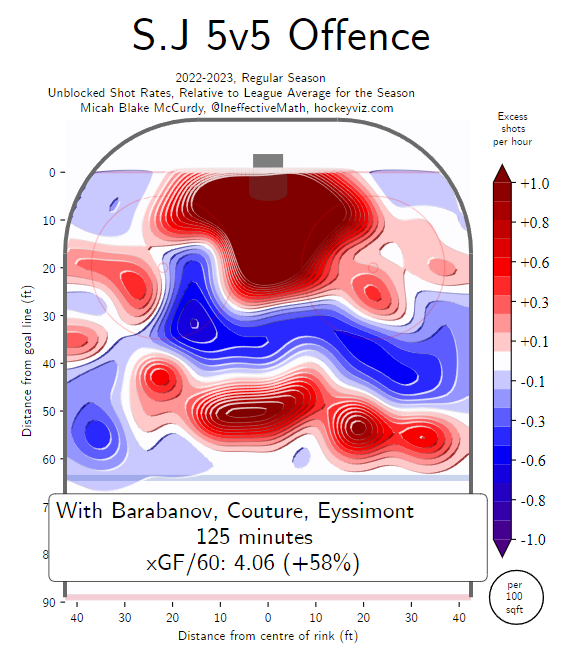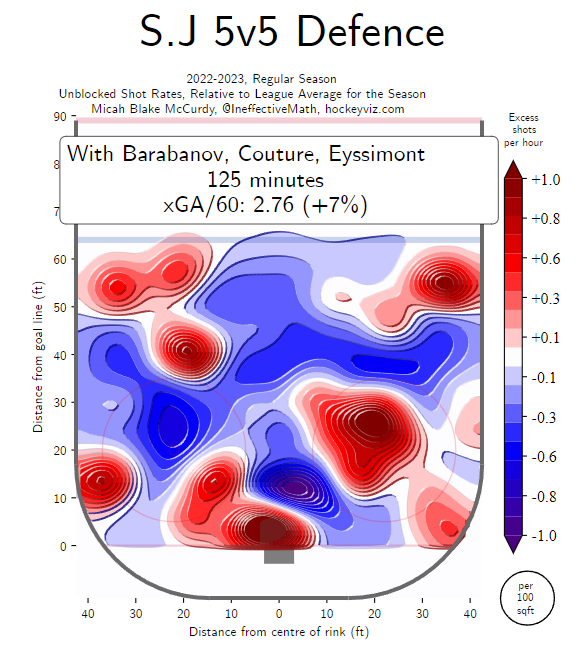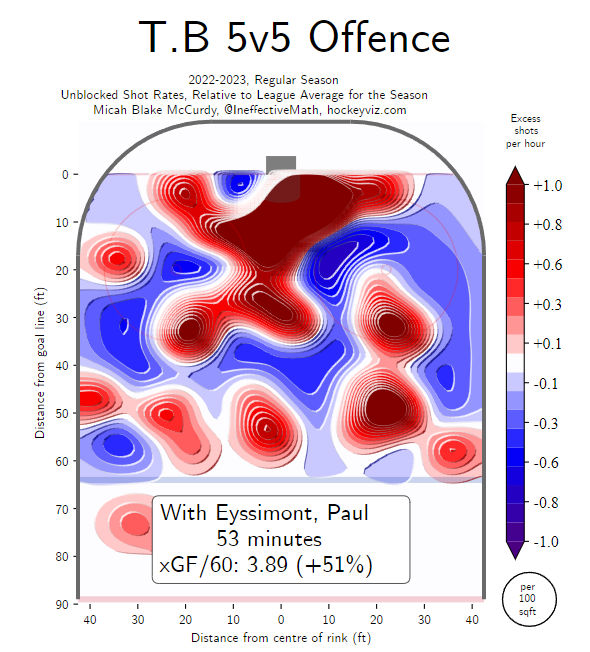Toronto and Tampa Bay start their series Tuesday night in Toronto. The Leafs are trying to finally take that next step as a franchise while the Lightning are trying to hang on to their dynastic hopes. It is a series loaded with intrigue, but let’s add another layer.
Tanner Jeannot was acquired by Tampa Bay in a then-widely discussed trade. The total haul was five draft picks, though just one could end up a first rounder and three were in the third round or later. Regardless, he didn’t make much of an impact on his arrival, scoring one goal in 20 games, amassing just four points total, and the team was out-scored 11-4 with him on the ice. He is now injured, though he could return at some point in the series.
It means the Lightning have to go to some depth for a roster option, and it brings us to the point: Michael Eyssimont. The 26-year-old forward is slotted to skate alongside Ross Colton and Nick Paul on one of the two bottom-6 forward lines for Tampa Bay. He was acquired from San Jose for Vladislav Namestnikov, who ultimately ended up in Winnipeg. San Jose originally claimed him off waivers from Winnipeg, who had signed him to a two-year, two-way deal the prior offseason. Eyssimont had five goals and 15 points in 54 games for three teams.
But the points belie the reason for discussing him: everything else about his game. He had just one NHL game prior to this year, so this season is all we have to go from, but it was an anomalous year:
- Of the 347 forwards with at least 600 minutes at 5-on-5 this season, per Natural Stat Trick, Eyssimont was 10th in shot attempt rate, behind Tyler Toffoli and ahead of Nazem Kadri.
- By individual expected goals per 60 minutes, he was sixth, just behind Zach Hyman and just ahead of Tage Thompson.
- When he was on the ice, his teams out-scored the opposition 28-25, scoring nearly 53% of the goals.
- Evolving Hockey has his even-strength expected goal impact 42nd in the league among qualified forwards, easily a first-line rate.
- His even-strength goal impact was much less than his expected goal impact, but still rated as a low-end second-line forward.
He had elite shot rates, great expected goals impacts, good goals impacts, and seemed to help his teams a lot at even strength. Despite all that, he managed his way to three franchises. Let’s talk about his season with a bit more context.
Eyssimont was a fifth-round pick in 2016, with Los Angeles taking him 142nd overall. He spent three full seasons in the AHL before signing with Winnipeg in the 2021 offseason. At that point, he hadn’t done a lot that was notable, but the 2019-20 AHL season did see him finish with 12 goals in 56 games on 145 shots. It was a sign of life, but he shot 8.3% and moved on.
It’s the 2021-22 AHL season where things get interesting.
In his first year with the Manitoba Moose, Eyssimont posted 18 goals and 42 points in 58 games. He also put up 205 shots on goal, or 3.5 shots per game. He led the Moose in points and played fewer games than his teammates chasing him all while putting up a monster shot rate.
Fast forward to October of 2022 and Eyssimont starts in the AHL. He puts up 2 goals and 9 points in 9 games while averaging 3.7 shots per game. The call-up comes in November, and he plays just 19 games, scoring once, and tallying five points. His most-common line mates were Pierre-Luc Dubois and Kyle Connor, and they out-scored the opposition 6-1 in 62+ minutes of ice time together. His shot rate trailed only Connor and Blake Wheeler in his brief Jets tenure. However – and readers will notice a developing theme – he shot under 4%, and that is very sub-optimal. To be fair here, when you play with Dubois and Connor, you’re not going to be the one taking all the shots. It is why the Jets didn’t get to the net a lot with Eyssimont on the ice and Connor taking his wing shots, as HockeyViz shows:

Winnipeg waived Eyssimont early in January and he was picked up by San Jose. Alexander Barabanov and Logan Couture had Eyssimont on their wing for nearly 125 minutes at 5-on-5 with the Sharks. Again, they crush the opposition, carrying over 64% of the expected goal share, out-scoring the opposition 10-7, or nearly 59% of the goals. Keep in mind: this is on a San Jose team that was one of the worst in the league, finishing minus-52 at 5-on-5 this season. This is what the expected goals for/against look like, visually, from HockeyViz:


Eyssimont scored three times in 20 games, but did so on 57 shots, or a conversion rate of 5.3%. Again, his line out-scored the opposition, again he put up a good shot rate (this one, actually, was elite at 21.4 attempts per 60 minutes), but his inability to finish hampered what could have been an even better performance.
San Jose trades him to Tampa Bay and things go off the rails a bit. He gets out-scored and the team shoots just 2.2% with him on the ice. The crux is that in 53 minutes with Nick Paul as his centre, the Lightning break even on goals, and control 62% of the expected goal share. Again, visually, this is what it looks like on offence with Eyssimont and Paul on the ice, and it looks very similar to what he did in San Jose:


Remember, this is a guy with 238 shots in his last 67 AHL games. That he’s playing with guys like Paul and Couture and that they get more shots around the net – his calling card – makes sense.
There is also the concern of chemistry here. In Ottawa, per Corey Sznajder’s tracking data, Paul played off the cycle/forecheck more than off the rush by a considerable margin. In a small sample, that is what Eyssimont did in San Jose. He did both, really, but his shot rate off the cycle was among the league leaders. He did it a lot, and with his centre playing the same way, it could lead to quick chemistry for them, aside from the 50-plus minutes already spent together.
Of course, like everywhere else, the team is shooting 2.8% with Paul and Eyssimont on the ice. This has been a hallmark at every stop in the NHL. He also shot just 8.4% on those 238 shots in the AHL as he started breaking out. Back during the 2021 pandemic season in the AHL, he scored nine times on 135 shots, or 6.7%. While we shouldn’t put a lot of stock into 55 NHL games, he also has three recent AHL seasons with the exact same issue. That he is driving play so well – combined with some good goaltending – is why they keep out-scoring the opposition.
Here we have a player that led his team in points and shots (by a wide margin) in the AHL but had problems finishing. He is driving the play in the NHL but is having even more problems finishing, as we might expect. But if he can keep driving the play at a 60% rate, do they dominate the play enough to make a difference?
The last point to make is one of luck. Hockey has a lot of it, and it’s a huge factor in postseason success. At the same time, if players driving the play to this level can endure some good luck for a month, or a couple weeks, they can win hockey games. Even if they don’t get lucky, they can dominate the play enough to break even on goals, or come close to it, as Eyssimont showed with Paul in their brief time together.
It brings us to the series against the Toronto Maple Leafs. They roll into the playoffs with a well-known postseason drought. Tampa Bay looked very shaky over the final two months of the season, ranking 23rd by points percentage over their final 30 games. It is a great opportunity for the Leafs to rid themselves of the playoff disappointments.
Toronto traded forward Pierre Engvall to the New York Islanders before the Trade Deadline. Over the last two seasons, the Leafs out-scored the opposition 57-51 with Engvall on the ice, or nearly 53% of the goals, while controlling nearly 56% of the expected goals. The trade is relevant because since he left Toronto, Toronto’s bottom-6 is out-scoring the opposition 12-9 but carrying just 42% of the expected goal share. They can thank their goalies for putting up a .945 SV% because even a .925 would have seen them get out-scored.
The theory goes like this: if Eyssimont-Paul keep dominating as they have, and Toronto’s bottom-6 doesn’t generate more offence, can the new Lightning third line create a meaningful difference in a 7-game series? Hockey fans are going to find out soon enough.
We are still working with small sample sizes here and there is no telling how good (or not) Eyssimont will be in the long-term. However, if he can maintain his regular season play into the postseason, not only can he have a positive impact in Tampa Bay’s bottom-6, which is valuable in itself, but his line could win them hockey games. It makes for a fascinating story heading into a series that has no shortage of them.